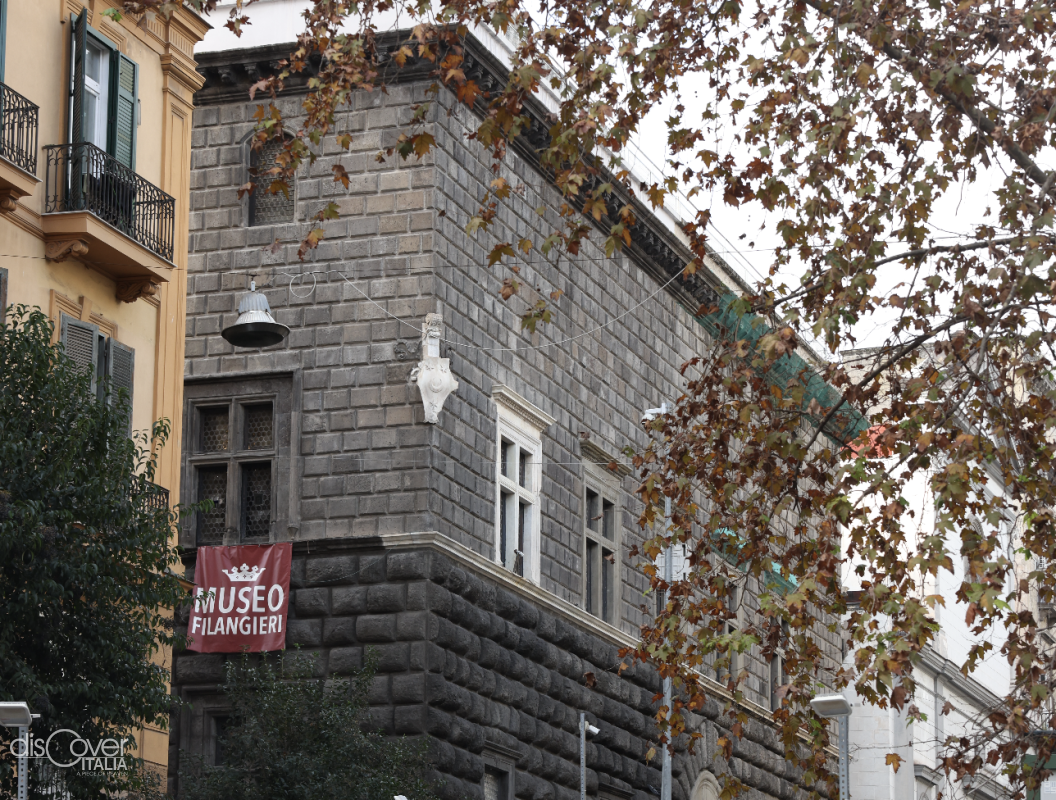Coming down via Duomo, on the right, next to the church of San Severo al Pendino, is Palazzo Como or Cuomo, a wonderful example of Renaissance architecture in Naples, as well as home to the Gaetano Filangieri Civic Museum.
The history of this building is inextricably linked to the Como family and goes back a long way, even if the date of construction is still a subject of debate.
The palace was most likely built starting from 1404, but the information on the first years of its construction is very incomplete. We certainly know that in 1451 Giovanni Como purchased a building behind it and a garden to expand his home. The expansion works began in 1464, but continued slowly, because in the meantime Angelo Como, another member of the family, had problems purchasing a garden that a certain Francesco Scannasorice refused to sell. Even King Alfonso II of Aragon had to intervene to resolve the dispute. He personally decided to purchase the garden in question and subsequently donate it to the Como family for his services, since Leonardo Como, Angelo's son, was his secretary. The construction work was thus completed, but in the following centuries the palace experienced ups and downs, as both the Aragonese dynasty and the Como family fell into ruin. At the beginning of the nineteenth century the palace even housed a brewery, although some rooms were used as the Archive of the Kingdom of the Two Sicilies.
During the Redevelopment works it was decided to widen via Duomo and what remained of Palazzo Como, in particular the characteristic façade, risked being demolished between 1879 and 1882. Fortunately, Gaetano Filangieri, prince of Satriano, intervened and, in order not to see it completely destroyed, decided to carry out some modernization work on the property at his own expense. The ancient structures, in fact, were dismantled, reassembled and set back about twenty meters to make room for the emerging Via Duomo, hence the name "walking palace" with which it has been defined since then. When, immediately afterwards, Filangieri donated his art collections to the Municipality of Naples, it was decided to place them inside that building for public use.
From an architectural point of view, Palazzo Como is immediately recognizable for its piperno façade, which is based on that of the Palazzo di Diomede Carafa in via San Biagio dei Librai and Palazzo Gravina in via Monteoliveto. The model, clearly, is Tuscan and the façade is divided horizontally into two sections: in the lower one we have a pure ashlar with protruding ashlars, while at the top we can appreciate a smooth ashlar.
The Civic Museum
The Gaetano Filangieri Civic Museum, inaugurated in 1888, houses important works of art and manuscripts of great historical interest.
The itinerary begins from the room on the ground floor dedicated to Carlo Filangieri, illustrious military man, minister of war during the reign of Francis of Bourbon, father of the prince, but above all son of the most illustrious "knight" Gaetano Filangieri, one of the greatest exponents of the Enlightenment European, author of the "Science of Legislation", inspiration for the Declaration of Independence of the United States of America which borrowed the principle of the right to happiness from it.
The room houses sculptures from various eras, but above all eighteenth-nineteenth century war relics, in particular a precious collection of weapons and armour, as well as medals and decorative objects such as plates, porcelain, ivories and majolica, all of oriental origin. The space is divided into three bays with vaults decorated with mosaics on a gold background. The fulcrum of the exhibition area is undoubtedly the bust of Carlo Filangieri, a work by the Neapolitan sculptor Tito Angelini.
The Agata Room on the upper floor is dedicated to Agata Moncada di Paternò, mother of Prince Gaetano Filangieri. The majolica floor is very suggestive and features decorations with coats of arms and shields of the family. It was created by the Industrial Artistic Museum of Naples under the direction of Filippo Palizzi and Giovanni Tesorone. On the ceiling you can admire a large iron and glass skylight, decidedly avant-garde in 1888 when it was installed. In the room you can admire pictorial works from the seventeenth, eighteenth and nineteenth centuries, signed among others by LucaGiordano, Mattia Preti, Andrea Vaccaro and Jusepe de Ribera, as well as precious porcelains from the Meissen and Capodimonte/Ferdinandea factories with works by Filippo Tagliolini kept in valuable sculpted wooden display cabinets.
Numerous works, no less precious, were destroyed by the Germans during the last world war. At the end of the war, thanks to other important contributions from Neapolitan art collectors, it was possible to reopen the museum which, in 2020, also acquired the famous portrait of the philosopher Gaetano Filangieri painted by Giuseppe Bonito.
The Library with the letters of the philosopher Gaetano Filangieri
A wooden hanging passage along the walls of the room leads to the Library, which houses over fifteen thousand volumes, and to the Historical Archive with documents dated between the 13th and 19th centuries.
A refined period setting with elegant walnut shelves and antique furniture from Prince Filangieri's study is the setting for the collections of books and magazines, including the D’Ambra Fund with documents on Neapolitan music and theatre between the 17th and 19th centuries, 150 parchments on the history of Naples, handed down by the Filangieri family. Of particular interest, at the Archive, is the exhibition of the correspondence between Gaetano Filangieri and Benjamin Franklin, who met during the American scientist's stay in Naples, when Filangieri had already published the first two books of his "Science of Legislation”, translated and distributed in all the main European countries. Filangieri's theoretical elaboration, the subject of the letters, left important and recognized traces in the Declaration of Independence and in the Constitution of the United States in whose drafting Franklin participated.
Information
Open Monday through Saturday from 10 a.m. to 4 p.m.
Full price ticket: €5




Comments powered by CComment